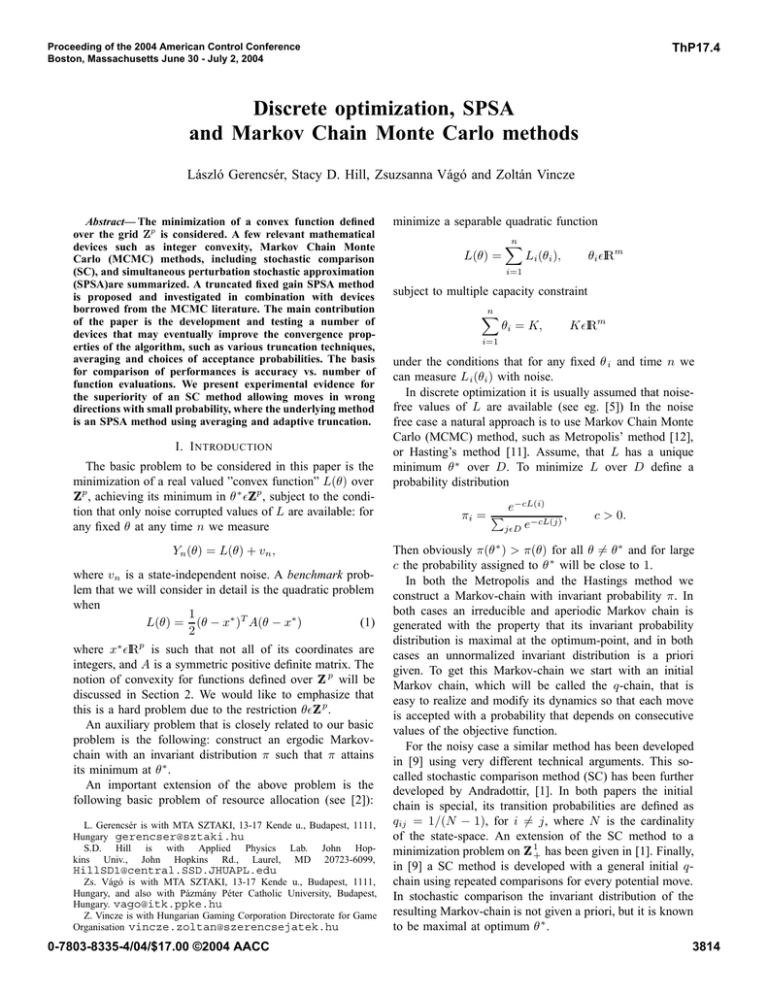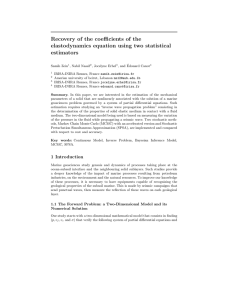Discrete optimization, SPSA and Markov Chain Monte Carlo methods
advertisement

ThP17.4
Proceeding of the 2004 American Control Conference
Boston, Massachusetts June 30 - July 2, 2004
Discrete optimization, SPSA
and Markov Chain Monte Carlo methods
László Gerencsér, Stacy D. Hill, Zsuzsanna Vágó and Zoltán Vincze
Abstract— The minimization of a convex function defined
over the grid Z p is considered. A few relevant mathematical
devices such as integer convexity, Markov Chain Monte
Carlo (MCMC) methods, including stochastic comparison
(SC), and simultaneous perturbation stochastic approximation
(SPSA)are summarized. A truncated fixed gain SPSA method
is proposed and investigated in combination with devices
borrowed from the MCMC literature. The main contribution
of the paper is the development and testing a number of
devices that may eventually improve the convergence properties of the algorithm, such as various truncation techniques,
averaging and choices of acceptance probabilities. The basis
for comparison of performances is accuracy vs. number of
function evaluations. We present experimental evidence for
the superiority of an SC method allowing moves in wrong
directions with small probability, where the underlying method
is an SPSA method using averaging and adaptive truncation.
I. I NTRODUCTION
The basic problem to be considered in this paper is the
minimization of a real valued ”convex function” L(θ) over
Zp , subject to the condiZ p , achieving its minimum in θ ∗ Z
tion that only noise corrupted values of L are available: for
any fixed θ at any time n we measure
Yn (θ) = L(θ) + vn ,
where vn is a state-independent noise. A benchmark problem that we will consider in detail is the quadratic problem
when
1
(1)
L(θ) = (θ − x∗ )T A(θ − x∗ )
2
where x∗ IRp is such that not all of its coordinates are
integers, and A is a symmetric positive definite matrix. The
notion of convexity for functions defined over Z p will be
discussed in Section 2. We would like to emphasize that
this is a hard problem due to the restriction θZ
Z p.
An auxiliary problem that is closely related to our basic
problem is the following: construct an ergodic Markovchain with an invariant distribution π such that π attains
its minimum at θ ∗ .
An important extension of the above problem is the
following basic problem of resource allocation (see [2]):
L. Gerencsér is with MTA SZTAKI, 13-17 Kende u., Budapest, 1111,
Hungary gerencser@sztaki.hu
S.D. Hill is with Applied Physics Lab. John Hopkins Univ., John Hopkins Rd., Laurel, MD 20723-6099,
HillSD1@central.SSD.JHUAPL.edu
Zs. Vágó is with MTA SZTAKI, 13-17 Kende u., Budapest, 1111,
Hungary, and also with Pázmány Péter Catholic University, Budapest,
Hungary. vago@itk.ppke.hu
Z. Vincze is with Hungarian Gaming Corporation Directorate for Game
Organisation vincze.zoltan@szerencsejatek.hu
0-7803-8335-4/04/$17.00 ©2004 AACC
minimize a separable quadratic function
L(θ) =
n
θi IRm
Li (θi ),
i=1
subject to multiple capacity constraint
n
θi = K,
KIRm
i=1
under the conditions that for any fixed θ i and time n we
can measure L i (θi ) with noise.
In discrete optimization it is usually assumed that noisefree values of L are available (see eg. [5]) In the noise
free case a natural approach is to use Markov Chain Monte
Carlo (MCMC) method, such as Metropolis’ method [12],
or Hasting’s method [11]. Assume, that L has a unique
minimum θ ∗ over D. To minimize L over D define a
probability distribution
πi = e−cL(i)
,
−cL(j)
jD e
c > 0.
Then obviously π(θ ∗ ) > π(θ) for all θ = θ ∗ and for large
c the probability assigned to θ ∗ will be close to 1.
In both the Metropolis and the Hastings method we
construct a Markov-chain with invariant probability π. In
both cases an irreducible and aperiodic Markov chain is
generated with the property that its invariant probability
distribution is maximal at the optimum-point, and in both
cases an unnormalized invariant distribution is a priori
given. To get this Markov-chain we start with an initial
Markov chain, which will be called the q-chain, that is
easy to realize and modify its dynamics so that each move
is accepted with a probability that depends on consecutive
values of the objective function.
For the noisy case a similar method has been developed
in [9] using very different technical arguments. This socalled stochastic comparison method (SC) has been further
developed by Andradottir, [1]. In both papers the initial
chain is special, its transition probabilities are defined as
qij = 1/(N − 1), for i = j, where N is the cardinality
of the state-space. An extension of the SC method to a
minimization problem on Z 1+ has been given in [1]. Finally,
in [9] a SC method is developed with a general initial qchain using repeated comparisons for every potential move.
In stochastic comparison the invariant distribution of the
resulting Markov-chain is not given a priori, but it is known
to be maximal at optimum θ ∗ .
3814
Taking advantage of the structure of the set Z p we propose to use a q-chain that imitates the move of a stochastic
gradient or stochastic Newton-method. Since the gradient
of L is not available, and L itself is evaluated with noise
we propose to use a discrete version of the SPSA method
(simultaneous perturbation stochastic approximation). For
minimization problems over IR p this has been developed in
[13] and [14], see also [4] and [6]. A discrete SPSA method
has been first presented in [8]. We use a truncated fixed gain
SPSA method and the stability of the method is ensured by
a resetting mechanism.
The main contribution of the paper is the development
and testing a number of devices that may eventually improve the convergence properties of the algorithm. These
devices include: various truncation techniques, averaging,
and choices of acceptance probabilities. The basis for comparison of performances is accuracy vs. number of function
evaluations. These results will be summarized in Section 5.
Convexity over Z p is an important practical issue to
ensure that a local minimum of L is in fact a global
minimum (see [5]. We cite only the following results:
Proposition 1: Let f be an integrally convex function on
a discrete rectangle X. If x is a local minimum point for f
over X, then x is a global minimum point.
Proposition 2: Let
f (x) = xT Cx + dT x.
Assume, that C is symmetric,
positive definite and diagn
onally dominant, i.e. j=1,j=i |cij | ≤ |cii |, i = 1, ..., n..
Then f is integrally convex.
II. M ARKOV C HAIN M ONTE C ARLO METHODS
Let L(θ) be a function defined over some abstract, finite
or countable set D, the elements of which are sometimes
identified with natural numbers 1, 2, . . .. Assume, that L
has a unique minimum θ ∗ over D. To minimize L over D
define a probability distribution
πi = e−cL(i)
,
−cL(j)
jD e
c > 0.
Then obviously π(θ ∗ ) > π(θ) for all θ = θ ∗ and for large
c the probability assigned to θ ∗ will be close to 1.
In both the Metropolis and the Hastings method we
construct a Markov-chain with invariant probability π. Both
methods rely on the following observation the proof of
which is straightforward (see [10]):
Lemma 1: Let P = (pij ) be a transition matrix of a
Markov-chain over a finite or countable state space Θ and
let π = (πi ) be a probability distribution written as a row
vector over Θ. Then
πi pij = πj pji
∀i = j
(2)
implies that π is invariant for P , i.e. πP = π.
In both methods a Markov-chain satisfying (2), called a
p-chain, will be constructed so that we start with an initial
Markov-chain with transition matrix Q = (q ij ), called
the q-chain, and its dynamics is modified by accepting a
move from i to j, i = jwith a pre-computed acceptance
probability τij . The p-chain will thus be defined by
pij = qij τ i j.
In the Metropolis-method the q-chain is symmetric, i.e.
qij = qji ,
∀i, j. In the more general Hastings method
the q-chain is non-symmetric, and the acceptance probabilities τij are given by
πj qji
,1 ,
τij = min
πi qij
if qij = 0 and τij = 0 otherwise.
The advantage of the Metropolis method over the Hastings method is that the explicit knowledge of the transition
probabilities qij is not required. On the other hand the
restriction that (qij ) must be symmetric is quite severe.
Rate of convergence. If the p-chain is irreducible and
aperiodic the n-step transition kernel P n (x, A) converges
to the invariant measure π in total variation. The rate of
convergence depends on Q and the acceptance probabilities
τ . The estimation of the rate of convergence is not trivial,
but it can be estimated in the case of a so-called independent
q-chain, i.e. when q ij = qj for all i, j. The following result
is given in [16].
Theorem 1: Let qij = qj for all i, j and assume that
qj ≥ βπj for all j, with 1 > β > 0. Then for all A
|P n (x, A) − π(A)| ≤ (1 − β)n .
Note that the acceptance probability for an independent
q-chain is defined by
πj qi
τij = min
,1 .
πi qj
The limitations of the Metropolis-Hastings method is that
the q-chain must be either symmetric or explicitly known.
Now assume a q-chain is constructed by exploiting the
special structure of the problem, such as a discrete SPSA
method to be described in Section 4. Then Q is neither
symmetric nor explicitly known. Therefore it can not be
used as the initial q-chain for a Metropolis-Hastings method.
Since we have a large degree of freedom in choosing τ ij
by using different strictly monotone transformations of L
we may try to find an appropriate τ ij directly. A simple
heuristic leads to the following choice:
ε > 0 if L(j) > L(i)
,
τij =
1
otherwise
where ε > 0 is fixed.
Conjecture. For small ε the unique invariant probability
of the p-chain with p ij = qij τij is maximal at θ ∗ .
The stochastic comparison method. The MetropolisHastings method is not applicable when the function values
are evaluated with noise. In this case we follow a different
path: our objective now is to construct an irreducible,
aperiodic Markov-chain such that its invariant probability
3815
distribution is maximal at θ ∗ . This objective is achieved by
the stochastic comparison method (SC) originally proposed
by Andradottir [1]. In contrast to the Metropolis-Hastings
method, in the original formulation of the SC method
the q-chain is not arbitrary. Let Θ = {1, . . . , N } be the
state space. In our problem (1) we simply enumerate the
gridpoint of a bounded domain D ⊂ Z p . Let θ ∗ = 1 be the
minimizing point. The q-chain is defined by
1
for i = j.
qij =
(N − 1)
If a move from i to j is generated by the q-chain at time n
then it is accepted if
transition probability of the reverse chain. Assume that both
P and P are adapted to L. Then the invariant probability
of P , denoted by π, is adapted to L.
Proof: We have for all i, j
πi P ij = πj Pji
and πj P ji = πi Pij .
From here
P ij =
πj
pji
πi
and P ji =
πi
pij .
πj
Let i < j and assume that πj > πi . Then Pji > Pij implies
P ij > P ji , a contradiction.
III. SPSA OVER Z p
yn+1 (j) < yn (i).
To approximate the gradient of L we use simultaneous
random perturbations (see [13]). The advantage of SPSA is
that only two function values are needed to get an unbiased
τij = P (yn (i)−yn+1 (j) > 0) = P (vn −vn+1 > L(j)−L(i))
estimator of the gradient, irrespective of the dimension. Let
(3) θ be the current approximation of θ ∗ and let k be the
It is easy to see that the p-chain with p ij = qij τij satisfies
iteration time. We take a random vector
the following criterion:
∆ = ∆k = (∆k1 , ..., ∆kp )T ,
Condition 1: The transition probability matrix P is
strictly adapted to L in the following sense:
where ∆ki is a double sequence of i.i.d. random variables.
(i) for any i, j = 1 p i1 > pij
A standard choice is to take a Bernoulli-sequence, taking
(ii) for any i, j = 1 p 1j ≤ pij
values +1 or −1 with equal probability 1/2. We take two
(iii) for any i = j p i1 ≥ p1i
measurements at L(θ + ∆) and L(θ − ∆). Note that the
The following proposition is essentially given in [1]:
perturbation is not scaled, since we have to stay on the
Proposition 3: Let P be the transition matrix of an
grid. In fact, for quadratic functions scaling is not needed:
irreducible, aperiodic Markov-chain and let P be strictly
its role is to keep down the effect of the third error terms
adapted to L. Then π 1 > πi for all i = 1.
in the Taylor series expansion of L. Let L θ (theta) denote
The realization of the initial q-chain with q ij = 1/(N −1)
the gradient of L at θ. Thus we get the following direction
for i = j may be impractical for large N -s. If the state-space
of move:
has some neighborhood structure then it would be desirable
H(θ) = ∆−1 ∆T Lθ (θ),
to work with a Q-matrix allowing only local connections.
−1 T
Definition 1: A q-chain is adapted to L if L(i) ≤ L(j)
where ∆−1 = (∆−1
1 , ..., ∆p ) . Now we are ready to deimplies qij ≤ qji .
fine a stochastic gradient step, which is a fixed gain version
Taking a symmetric Q we have the following result:
of the simultaneous perturbation stochastic approximation
Proposition 4: Let Q be symmetric. Then the p-chain
or SPSA method constrained to Z p :
generated by the SC method is adapted to L.
θn+1 = θn − [aH(n, θn )],
The proof is trivial. Unfortunately, it does not in general
follow that the invariant distribution for P is maximal at
where [ ] is the integer part coordinatewise, we also write
θ∗ .
[θ] = round(θ). In general we use a mapping
A straightforward extension of the SC method to general
πZ (θ) : IRp → Z p
Q-s can be obtained using repeated comparisons, thus
ensuring that the acceptance probabilities τ ij will be close
and use the correction term πZ (aHn (θn ))). An alternative
to 0 for L(j) > L(i) and close to 1 for L(j) < L(i). Then
correction term is obtained if by using an extension of the
assuming the validity of our we would conclude that the
sign-function. For any real number y define
invariant probability of the p-chain will be maximal at θ ∗ .
⎧
if y ≥ 1/2
⎨ 1
However a large number of small entries in the p-matrix
0
if |y| < 1/2,
sgn(y) =
imply slow rate of convergence.
⎩
−1 if y ≤ −1/2
In the following definition we impose a much stronger
condition on the invariant distribution, than being maximal
and for any p-vector x set sgn(x) = (sgn(x 1 ), ..., sgn(xp )).
at θ∗ .
Then set
Definition 2: A probability distribution π on Θ is
πZ (θ) = sgn(θ).
adapted to L if L(i) > L(j) implies π i < πj .
Thus we get the signed, fixed gain SPSA-method. Note that
Lemma 2: Let P be the transition probability of an
for sufficiently small gains a the correction becomes 0. The
irreducible, aperiodic Markov-chain and let P denote the
Thus the acceptance probability is
3816
purpose of letting πZZ(y) = 0 for |y| < 1/2 is to allow small
moves with lots of 0 coordinates.
A compromise between the above two procedures is
obtained by defining
x
) = sigh (x) h > 0
πZZ(x) = round(h
||x||∞
which allows more variability in the length of the truncated
vector, but its L ∞ -norm is bounded by a pre-fixed h.
Lemma 3: For strictly convex quadratic functions L the
Markov-chain generated by a fixed gain truncated SPSA
method using sig h satisfies
pij ≤ pji
for L(j) ≥ L(i),
i.e. it is adapted to L.
A simple and useful variant of the fixed gain, truncated
SPSA method is obtained if our starting point is a second
order SPSA method developed in [15]. It has been shown
there that using three function values per iteration a consistent estimator of the Hessian matrix of L can be obtained.
This estimate can be used in a Newton-like procedure.
Following Spall [14] we estimate the Hessian of L as
follows: assume that the gradient of L, denoted by g is
available, then we can apply the SP procedure for each
component of g and we would finally end up with the
estimate
= 1 ∆−1 δg T
A
2c
where δg = g(θ + c∆) − g(θ − c∆). Now since g is not
available we have to resort to its estimate. Using one-sided
estimate of g we have for any θ the estimate
˜ −1 [L(θ + c∆)
˜ − L(θ )]/c .
ĝ(θ ) = ∆
Substitute this in place of g. To ensure that our estimate of
H is symmetric, we symmetrize it. Thus the final estimate
will become
1 1
1
 = [ ∆−1 δĝ T + δĝ∆−T ] .
2 2c
2c
Obviously E Ĥ = A. Consider the special case when
∆ = ei = (0, . . . , 1, 0, . . . , 0)T with 1 at the i-th position,
˜ = ej with i, j random, uniform over {1, . . . , p}. Such a
∆
selection of ∆ will be called a random coordinate vector
(RCV) Then we get for the symmetrized Â
1
 = [Aij + Aji ]
2
where Aij is the matrix with 0-s in all positions except
in i, j, where the entry is (a ij ). The argument indicates a
potential shortcoming of using ∆ = e i , namely in higher
dimensions the matrix Ĥ will fill up very slowly. E.g. for
p = 200 we need cca. 20000 experiments to make sure that
all entries will be calculated.
For exploring the properties of fixed gain second order
SPSA method we actually pretend that A and thus A −1 are
known and define
H(n, θ) = A−1 ∆−1 ∆T Lθ (θ).
A second order SPSA method. Consider the following
fixed gain version of a second order simultaneous perturbation stochastic approximation (SPSA) method (see also
[7]):
(4)
θn+1 = θn − [aHn (θn )]
where a > 0 is the gain, and
T
∗
Hn (θ) = A−1 ∆−1
n ∆n A(θ − θ ).
(5)
IV. R ESOURCE ALLOCATION
Our interest in SPSA on grids is motivated by multiple
discrete resource allocation problems, which we shortly
describe. of discrete resource allocation is to distribute a
finite amount of resources of different types to finitely many
classes of users, where the amount of resources that can be
allocated to any user class is discrete. Suppose there are
n types of resources, and that the number of resources of
type i is Ni . Resources of the same type are identical. The
resources are allocated over M user classes: the number
of resources of type i that are allocated to user class j is
denoted by θ ij . The matrix consisting of the θ ij ’s is denoted
by Θ.
For each allocation the cost, such as performance or reliability is associated, which is denoted by L(Θ). We assume
that the total cost is weakly separable in the following sense:
L(Θ) =
M
Lj (θj )
j=1
where Lj (θj ) is the individual cost incurred by class j,
θj = (θij , ..., θij ), i.e. the class j cost depends only on the
resources that are allocated to class j. An important feature
of resource allocation problems is that often the cost L j is
not given explicitly, but rather in the form of an expectation
or in practical terms by simulation results.
Then the discrete, multiple constrained resource allocation problem is to minimize L(Θ) subject to
M
θij = Ni , θij ≥ 0, 1 ≤ i ≤ n.
(6)
j=1
where the θij ’s are non-negative integers. We will assume
that a solution exists with strictly positive components. Then
the minimization problem is unconstrained on the linear
manifold defined by the balance equations.
Problem (6) includes many problems of practical interest
such as the scheduling of time slots for the transmission of
messages over nodes in a radio network (cf.[3]). The above
problem is a generalization of the single resource allocation
problem with m = 1, see [2].
Cassandras et al. in [2] present a relaxation-type algorithm for the single resource, in which at any time the
allocation is rebalanced between exactly two tasks. For
multiple resource rebalancing between user j and k is based
on comparing the gradients ∂θ∂ j Lj (θj ) and ∂θ∂k Lj (θk ). The
computation of these gradients may require time-consuming
3817
simulation, hence we use their estimates obtained by simultaneous perturbation at time t, and denoted by H j (t, θj ).
Thus we arrive to the following recursion: at time t select
a pair (j, k) and then modify the allocation for this pair of
tasks as follows:
θj,t+1
=
θj,t + [a(Hk (t, θk ) − Hj (t, θj ))]
θk,t+1
=
θk,t − [a(Hk (t, θk ) − Hj (t, θj ))],
where a is a fixed gain. Obviously, the balance equations
are not violated by the new allocation. The selection of the
pair (j, k) can be done by a simple cyclic visiting schedule.
V. S IMULATION RESULTS
Simulations have been carried our for randomly generated
quadratic function
1
(θ − θ∗ )T A(θ − θ∗ )
(7)
2
in dimensions p = 50, 100. The eigenvalues of the symmetric matrix A have been generated by sampling from
an exponential distribution with parameter µ = 0.5, and
shifting them by a positive amount δ = 0.5. Then the
resulting diagonal matrix has been multiplied by p randomly
chosen rotations, where the pairs of indices defining the
plane of the rotation and the angle of rotation have been
both chosen uniformly. The coordinates of the continuous
optimum θ ∗ have been chosen randomly according to a
uniform distribution in [0, 1].
The initial point for the iteration is chosen by taking the
integer part of a sample from a standard normal distribution
N (0, Ip ). In all cases we add a resetting mechanism, which
in some cases - depending on the value of the rejection
probability - is dramatically active, to ensure stability of
the procedure. The exact value of the discrete optimum is
unknown, but a rough upper bound is obtained by evaluating
L at θ∗ = 0. We carry out our experiments on two
randomly generated test problems with dimensions 50 and
100, respectively, with various noise levels. The noise level
is determined by fixing a signal to noise ratio, say 2, and
then setting the variance of the noise, denoted by Σ, equal to
2 of the current function value. The simulation experiments
are of increasing complexity and in each step we vary one
aspect of the algorithm. All the plots show (noise free)
function values against the number of function evaluations.
Functions values are plotted on a logarithmic scale.
On Fig.1 the plain finite difference stochastic approximation (FDSA), and two SPSA methods are compared, with
two different truncation functions, sig 1 and sig3 . On Fig.2
the same experiment is repeated but with higher degree of
averaging: q = 5 as opposed to q = 2. We see that SPSA
is superior to FDSA in both cases, and averaging improves
the stability of the procedure. (Note the differences in the
vertical scale).
It is seen that in the choice of the truncation method
there is a trade-off: for large h we get faster initial descent
and for small h we get better stability. This motivates the
L(θ) =
introduction of an adaptive procedure: fix h 1 < h2 and
perform a step with both, then choose one of the two
resulting positions with smaller measured (noisy) function
value. The performance of an adaptive SPSA is compared
with two non-adaptive procedure on Fig.3.
A further improvement in stability can be achieved by
blocking moves in wrong directions following techniques
from MCMC. For this we use a fixed acceptance probability τ : if L(θn+1 ) > L(θn ) then we accept θn+1 with
probability τ . We found that choosing τ very small slows
down the algorithm considerably. A non-blocked procedure
is compared with two blocked procedures on Fig.4. It is
seen that τ = 0.04 considerably improves the performance
of the algorithm. Note that the number of function value
evaluations now include the number of comparisons before
an actual move is made. For τ = 0.3 40% of the moves
were blocked, while for τ = 0.04 the corresponding figure
is 73%.
For theoretical analysis a potential tool is a discrete
version of the ODE method. The quality of the method
can be partially assessed by computing the expected value
of the correction term H (whatever H means in different
procedures) and see if its angle with the gradient of L is less
than 90 degrees. It was found that for the best procedure
shown on Fig.4 this angle less than 5 degrees.
In most experiment Bernoulli SPSA and random coor√
dinate vectors (RCV) SPSA with ∆ = pei yield the
same performance. This is not the case for an interesting
application: resource allocation. We considered a problem
with 50 users and 10 types of resources, and found that
RCV SPSA is superior to Bernoulli SPSA. The results are
given on Fig.5.
ACKNOWLEDGEMENT
The first author expresses his thanks to James C. Spall
of the Applied Physics Laboratory of Johns Hopkins University for cooperating in this research.
R EFERENCES
[1] S. Andradottir. A method for discrete stochastic optimization.
Management Science, 41:1946–1961, 1995.
[2] C.G. Cassandras, L. Dai, and C.G. Panayiotou. Ordinal optimization
for a class of deterministic and stochastic discrete resource allocation
problems. IEEE Trans. Auto. Contr., 43(7):881–900, 1998.
[3] C.G. Cassandras and V. Julka.
Scheduling policies using
marked/phantom slot algorithms. Queueing Systems: Theory and
Appl., 20:207–254, 1995.
[4] H.F. Chen, T.E. Duncan, and B. Pasik-Duncan. A stochastic approximation algorithm with random differences. In J.Gertler, J.B.
Cruz, and M. Peshkin, editors, Proceedings of the 13th Triennal IFAC
World Congress, San Francisco, USA, pages 493–496, 1996. Volume
editors: R.Bitmead, J. Petersen, H.F. Chen and G. Picci.
[5] P. Favati and F. Tardella. Convexity in nonlinear integer programming. (53), 1990.
[6] L. Gerencsér. Rate of convergence of moments for a simultaneuous
perturbation stochastic approximation method for function minimization. IEEE Trans. Automat. Contr., 44:894–906, 1999.
[7] L. Gerencsér, S. D. Hill, and Zs. Vágó. Optimization over discrete
sets via SPSA. In Proceedings of the 38-th Conference on Decision
and Control, CDC’99, pages 1791–1794. IEEE, 1999.
3818
[8] L. Gerencsér, S. D. Hill, and Zs. Vágó. Discrete optimization via
spsa. In Proceedings of the American Control Conference, ACC’01,
pages 1503–1504. IEEE, 2001.
[9] W.B. Gong, Y.C. Ho, and W. Zhai. Stochastic comparison algorithm
for discrete optimization with estimation. SIAM J. Optimization,
10(2):384–404.
[10] J. M. Hammersley and D.C. Handscomb. Monte Carlo methods.
Fletcher & Son Ltd. Norwich, 1967.
[11] W. K. Hastings. Monte Carlo sampling methods using Markov chains
and their applications. Biometrika, 57(1), 1970.
[12] N. Metropolis, A. Rosenbluth, M. Rosenbluth, A. Teller, and
E. Teller. Equations of state calculations by fast computing machines.
J. Chem Phys., 21:1087–1091, 1970.
[13] J.C. Spall. Multivariate stochastic approximation using a simultaneous perturbation gradient approximation. IEEE Trans. Automat.
Contr., 37:332–341, 1992.
[14] J.C. Spall. Adaptive stochastic approximation by the simultaneous
perturbation method. In Proceedings of the 1998 IEEE CDC, pages
3872 – 3879, 1998.
[15] J.C. Spall. Adaptive stochastic approximation by the simultaneous
perturbation method. IEEE Trans. Automat. Contr., 45:1839–1853,
2000.
[16] R. L. Tweede. Markov chains: Structure and applications. Technical
report, Colorado State University, October 1998.
p=100, Σ=0.02*L(Θ)
SPSA, q=5, ΠZ=sig3
SPSA, q=5, Π =sig
6
10
Z
1
SPSA, q=5, adaptive stepsize
5
10
0
1000
2000
3000
4000
5000
6000
7000
8000
9000
10000
L(Θ) vs. number of function evaluations
Fig. 3.
p=100, Σ=0.02*L(Θ)
p=100, Σ=0.02*L(Θ)
5
10
SPSA, q=5, adaptive stepsize
SPSA & MCMC, q=5, τ=0.3, adapt. steps.
SPSA & MCMC, q=5, τ=0.04, adapt. steps.
6
10
FDSA, exact l. s.
SPSA, q=2, Π =sig
Z
1
SPSA, q=2, ΠZ=sig3
5
10
4
10
0
1000
2000
3000
4000
5000
6000
7000
8000
9000
10000
L(Θ) vs. number of function evaluations
0
1000
2000
3000
4000
5000
6000
7000
8000
9000
10000
L(Θ) vs. number of function evaluations
Fig. 1.
Fig. 4.
p=100, Σ=0.02*L(Θ)
6
6
10
2.4
FDSA, exact l. s.
x 10
Resource allocation, n=50, m=10, Σ=0.02*L(Θ)
FDSA, exact line search
SPSA, q=2, adaptive stepsize
2.2
2
1.8
SPSA, q=5, Π =sig
Z
3
1.6
5
10
1.4
1.2
SPSA, q=5, Π =sig
Z
1
1
0.8
0
1000
2000
3000
4000
5000
6000
7000
8000
9000
10000
0.6
L(Θ) vs. number of function evaluations
0.4
Fig. 2.
0
1
2
3
4
5
6
7
8
L(Θ) vs. number of function evaluations
9
10
4
x 10
Fig. 5.
3819






